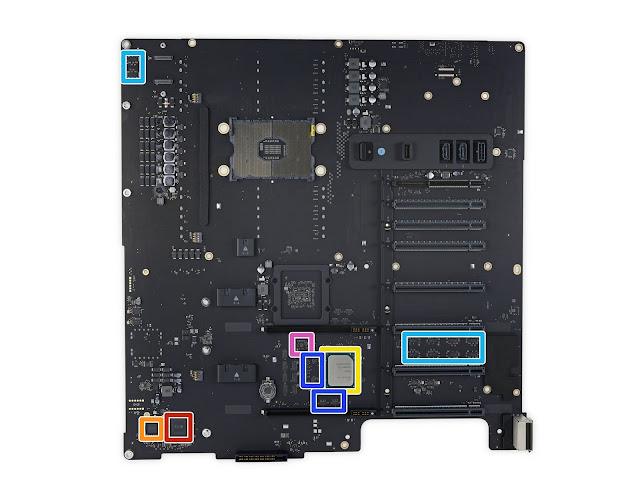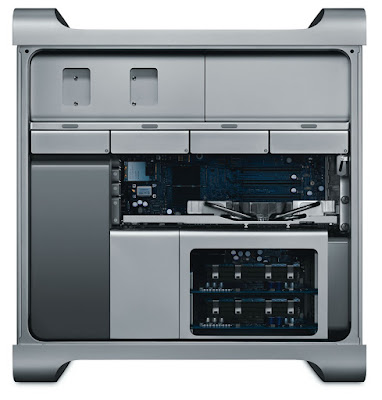Is the Southbridge Dead?
The main component on the logic board of the new 2019 Mac Pro is the massive PCIe switch that directs the pool of 64 PCIe lanes to the eight PCIe slots. At the same time, the role of the southbridge has all but vanished. None of the functions of the 33 different ports provided by the Intel® C621 southbridge are in use in a default configuration or the Mac Pro. Here Apple is setting a trend. Future PCs are likely to completely abolish the southbridge.
 |
| The Mac Pro 7,1 logic board by iFixit. The yellow rectangle marks the Intel C621 southbridge. |
What is a the southebridge?
Early PCs were built around a parallel bus. 8-bit computers from the 1970s would have a case with a passive backplane. Identical connectors would sit next each other, with the corresponding pins tied to each other in the backplane to form a bus. One connector would house a processor card while others would hold memory and input/output cards. In early PCs like the IBM PC and the Apple II the processor and part of the random access memory would be moved to the main board, now called the motherboard. Identical connectors were still placed next to each other, forming a 8-bit, and later 16-bit bus.
With a parallel bus everything in the computer had to be synchronized to a relative slow centralized clock. The speed of the computer was ultimately limited by the speed of light and distance between the end points of bus.
Modern computers have a star topology. A processor in the center communicates directly with peripheral components using bundles of high-speed serial channels called “lanes”. The speed and length of the communication channel are not limited by the speed of light. When a receiver reads a single bit many more bits may be traveling along the traces that make up the differential pair on the circuit board. In PCIe version 3.0 transitions happen 8 billion times a second. It the electrons could reach the speed of light, each wave of electricity would be at most 3.75 cm long, far less than the dimensions of any computer.
The transition from the archaic to the modern did not happen instantaneously. For decades a variety of bridges was used to connect parts of a PC that operated at different speeds and used different busses. The need for a bridge first arose in 1986 when Compaq introduced the Deskpro 386, starting the era of “IBM compatible” PCs. The Deskpro 386 used the new and fast 32-bit 80386 processor but retained the slow 16-bit ISA bus and slots inherited from the IBM AT and its 16-bit 80286 processor.
A full-fledged bridge-based PC from the early 2000s had three levels of of bridges, each representing evolutionary stages of the development of the PC. At the far end was the Super I/O chip handling all the “legacy” interfaces and protocols, each of which had required a dedicated add-on card on the ISA bus of the original IBM PC. The Super I/O would be connected to the southbridge, also called the I/O Controller Hub (ICH). The southbridge controlled the parallel PCI bus and the serial interfaces for USB, SATA hard drives and Ethernet networking. Another internal bus would connect the southbridge to the northbridge, also called the memory controller hub (MCH). The northbridge controlled the memory through the parallel address and data lines of the memory bus. It also controlled the serial PCIe lanes that populated the PCIe slots in the system. The northbridge again communicated with the processor through the frontside bus (FSB).
 |
| Typical architecture of an Intel Core 2 computer. |
The northbridge was eliminated in stages in the early 2010s. First the Intel Nehalem microarchitecture moved the memory bus directly to the CPU. Then the Sandy Bridge architecture moved the PCIe lanes to the processor. Communication between the processor and the southbridge happens over a Direct Media Interface (DMI), which is in fact a renamed four-lane x4 PCIe interface.
Right to reuse
The most important remaining function of the southbridge may be to serve as a license dongle that deprives Intel CPU owners the right to repair and reuse their processors in new applications. There is a huge supply of high-performance Intel processors that come from decommissioned servers. These would find a use in workstations and gaming rigs, if suitable motherboards existed. Some of the processors find their ways into 10 year-old Mac Pros. Intel sees this market as a threat to their sales of new processors.
Although the DMI interface is the same for all Intel processors, Intel demands that certain processors sold to a certain customer segment remain tied to a specific southbridge chip, even when the platform has no use for the functionality provided by the chip. Chinese motherboard manufacturers may have been able to bypass this limitation. These Chinese companies market “X79” motherboards for Sandy and Ivy Bridge server CPUs. It is unlikely that these new motherboards actually contain the expensive but outdated X79 Platform Controller Hub. I find it unlikely that Intel would even sell the chip to these Chinese manufactures. More likely a cheaper but more modern southbridge chip is used.
Technically the only thing that makes the southbridge necessary in the Intel architecture is the boot ROM. Modern EEPROM or flash memory chips use the four-wire Serial Peripheral Interface (SPI) for communication. Intel processors have thousands of pins in their socket, including several serial buses, but none of the pins is able to read flash memory. Instead the boot ROM must be connected to the southbridge. The processor can only start executing its firmware once it establishes the DMI connection to the southbridge and tells it to start reading the ROM. The details on how this happens are proprietary secrets and will be revealed by Intel only to people who have signed a non-disclosure agreement.
2019 Mac Pro
In the 2019 Mac Pro the southbridge serves little or no useful purpose. The two USB 3 ports and the one audio output that come with the system are provided by a modular PCIe card. Most external communication is handled by Thunderbolt 3 ports that the C621 is unable to provide. Serial ATA, the main feature of a south bridge, is as outdated as spinning hard drives. Modern PCs like the new Mac Pro store their data in flash memory. Any storage the user adds would be in the form of NVMe drives connected directly to the PCIe slots. The only ports in the system that may come form the C621 southbridge are the one internal USB 3 port for a license dongle and the two SATA ports. The SATA ports can only be used after the addition of the 400 dollar Pegasus J2i storage enclosure.
Looking at the placement of the C621 southbridge on the logic board between the two MPX connectors suggest another use for it. The chip might provide the USB 2 signal for the Thunderbolt 3 outputs in the MPX graphics card modules. But there too the functionality exists only for legacy support. USB 3 devises can negotiate a connection without the presence of a USB 2 channel.
Intel lists the price of the C621 “chipset” as 57 dollars. What ever functionality it provides could as well have been handled by the cheapest of the cheap consumer chips.
Originally posted to Facebook on December 22, 2019. Posted here and backdated on December 11, 2020.


Comments
Post a Comment